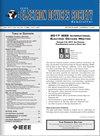Nanomole Process: Enabling Localized Metallic Back-Gates for Enhanced Cryogenic Front-to-Back Coupling in FDSOI Quantum Dots
IF 2.4
3区 工程技术
Q3 ENGINEERING, ELECTRICAL & ELECTRONIC
引用次数: 0
Abstract
This paper introduces a novel integration method of localized metallic back-gates into fully-depleted silicon-on-insulator (FDSOI) multi-gate FETs, enabling robust front-to-back electrostatic coupling from room temperature to cryogenic conditions, without the need for substrate implantation. The fabrication process, termed the Nanomole process, utilizes nanometric vapor-phase etching of the buried oxide or silicon substrate with vapor-HF and XeF2 gases. This is followed by atomic layer deposition (ALD) of a dielectric material and Pt, with precise patterning achieved through inductively coupled plasma etching. Detailed analysis of the process demonstrates controllable etch rates based on device geometry, providing calibrated guidelines for scalable manufacturing. Symmetric mid-k dual-gating is reported in devices featuring a Si-film thickness of 24 nm, with a top and bottom gate oxide equivalent thickness (EOT) of 6.5 nm. Electrical characterization of multi-gate FDSOI SETs, operated as FETs, confirms effective threshold voltage tuning through dual-gate operation, with consistent performance from room temperature to millikelvin regimes. Additionally, quantum mechanical simulations based on the effective mass approximation at 4 K offer insights into the electrostatic behavior of dual-gated SOI quantum dot devices in both planar and nanowire geometries. This scalable and versatile technological solution opens new possibilities for advanced quantum devices, such as charge and spin qubits, by enabling in situ control over volume inversion, electron valley splitting, and spin-orbit interaction.纳米分子工艺:在FDSOI量子点中实现局部金属后门以增强低温前后耦合
本文介绍了一种新的集成方法,将局部金属后门集成到完全耗尽的绝缘体上硅(FDSOI)多栅极场效应管中,实现了从室温到低温条件下的前后静电耦合,而无需衬底植入。这种制造工艺被称为纳米分子工艺,利用气相hf和XeF2气体对埋藏的氧化物或硅衬底进行纳米气相蚀刻。接下来是电介质材料和铂的原子层沉积(ALD),通过电感耦合等离子体蚀刻实现精确的图案。该工艺的详细分析证明了基于器件几何形状的可控蚀刻速率,为可扩展制造提供了校准指南。对称mid-k双门控器件的硅膜厚度为24 nm,上下栅极氧化物等效厚度(EOT)为6.5 nm。作为fet操作的多栅极FDSOI set的电气特性证实,通过双栅极操作可以有效地调节阈值电压,从室温到毫开尔文都具有一致的性能。此外,基于4 K有效质量近似的量子力学模拟提供了对平面和纳米线几何形状双门控SOI量子点器件的静电行为的见解。这种可扩展和通用的技术解决方案通过实现对体积反转、电子谷分裂和自旋轨道相互作用的原位控制,为先进的量子器件(如电荷和自旋量子比特)开辟了新的可能性。
本文章由计算机程序翻译,如有差异,请以英文原文为准。
求助全文
约1分钟内获得全文
求助全文
来源期刊

IEEE Journal of the Electron Devices Society
Biochemistry, Genetics and Molecular Biology-Biotechnology
CiteScore
5.20
自引率
4.30%
发文量
124
审稿时长
9 weeks
期刊介绍:
The IEEE Journal of the Electron Devices Society (J-EDS) is an open-access, fully electronic scientific journal publishing papers ranging from fundamental to applied research that are scientifically rigorous and relevant to electron devices. The J-EDS publishes original and significant contributions relating to the theory, modelling, design, performance, and reliability of electron and ion integrated circuit devices and interconnects, involving insulators, metals, organic materials, micro-plasmas, semiconductors, quantum-effect structures, vacuum devices, and emerging materials with applications in bioelectronics, biomedical electronics, computation, communications, displays, microelectromechanics, imaging, micro-actuators, nanodevices, optoelectronics, photovoltaics, power IC''s, and micro-sensors. Tutorial and review papers on these subjects are, also, published. And, occasionally special issues with a collection of papers on particular areas in more depth and breadth are, also, published. J-EDS publishes all papers that are judged to be technically valid and original.
 求助内容:
求助内容: 应助结果提醒方式:
应助结果提醒方式:


